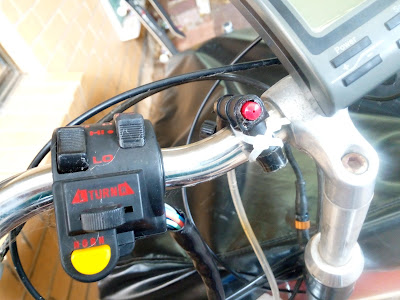This is a bit of a belated post to document how I added an air-conditioner to my bakfiets for my long rides to work in the summer. I used to work quite near by, but now work several days a week out the other side of the city -- 32km in each direction.
The big battery upgrade I did last year has been a wonder and joy for this, because it takes me about 3 hours return for the 64km, which I can do on a single charge. With the original battery, I wouldn't have even been able to make it one way, and then it would have taken 6 hours to charge it up during the day at work, and just generally would have sucked. But instead, I can charge the big battery in 2 hours easily over night, and be confident that I will get several hours of support from it.
But that's now what we are here to talk about today... Instead, it's adding air-conditioning for the ride home from work on hot summer days: Where I work now, I typically work 8am to 4pm. So summer mornings arriving by about 7:30 for a shower are lovely, but riding home in Adelaide summer between 4pm and 6pm means riding in the hottest part of the day.
Long-time readers might remember that this is not the first time I have added airconditioning to my bakfiets. The last time, I added a fan, because my commute involved a 10% grade clime, which meant that airflow was lacking. This time, I am typically sitting at 25km/h most of the time, so airflow isn't the problem, which means I can just make a simple evaporative cooler.
Also, last time, I had to add a power system, because the bakfiets had not yet received its electric assist system (yes, I used to ride up at 10% grade with a purely human powered bakfiets. It kept me very fit). But now, my bakfiets has a 28v electric assist system, which is within tolerance of truck battery voltage. I already have various other contraptions powered by this, including a 139dB truck/train air-horn, proper headlights made from a ditch-digger's flood lights and a rear flashing light that is the same model the Victorian police use on their field van to warn aircraft to avoid their mast and is so bright it reflects off of black bitumin roads.
I thought I had made blog posts about those, but it turns out I haven't. I'll fix that at some point. It is very therapeutic to have a horn that every motorist or music-listening pedestrian can hear when the need arises.
Anyway, the point being, I have truck DC voltage available. So I figured the easiest way to make an air-conditioner would be to get a truck window wiper washer bottle and pump, and connect it to a garden mister. Then I would be able to press a button to provide a water mist to damp me down, and thus provide the moisture for evaporation. And it works very nicely. I holds about 2L of water, which is more than enough for a 1.5 hour ride in 40C conditions. Typically I need to press the button for just a few seconds every couple of minutes to do the trick.
There is enough clearance at the back of the crate on the bakfiets to attach the bottle externally, which avoids any risk of 2L of water sloshing about next to a 1KWh lithium battery. This then connects to the mister on the handlebars and to a motor bike handle bar switch set:
The bottle I bought as a generic replacement part for trucks from one of the various online trucks parts places here in Australia. Cost me about AU$65
Finally, as this was making the wiring in the bakfiets crate even messier than it was before, I finally bit the bullet and totally re-wired it. 90% of the wiring now terminates into this nice long black tray that sits above the battery. It's actually the fuse box from an ancient Holden Commodore car from the 1980s that I bought at a wreckers for AU$20.
Using an automotive fuse box was a great idea, not just because it was cheap, but because it has lots of spots for relays and fuses, and existing heavy-gauge wiring. The shunt relay for the air-horn (because of its 250W power consumption, with up to 1KW in-rush power) fits in there nicely, and is much more reliable in stead of the old hacked-up arrangement I had previously.
This is what the inside of the fuse-box looks like:
Most of the work was ripping out all of the wiring that I didn't need from the loom. All that's left is the black shunt relay for the horn, the three main fuse blocks near the bottom for the motor, horn and head/tail lights, and the smaller fuses at the top that separately fuse various of the minor systems, including the 12V accessory plug, cooling fan for the motor controller and USB charging ports.The bakfiets is now almost exactly 10 years old, and has been ridden well over 30,000km, and continues to evolve together with my life. Hopefully, I'll get a few more years out of it, yet, before I have to replace the whole thing. With a newer cargo bike, of course...




